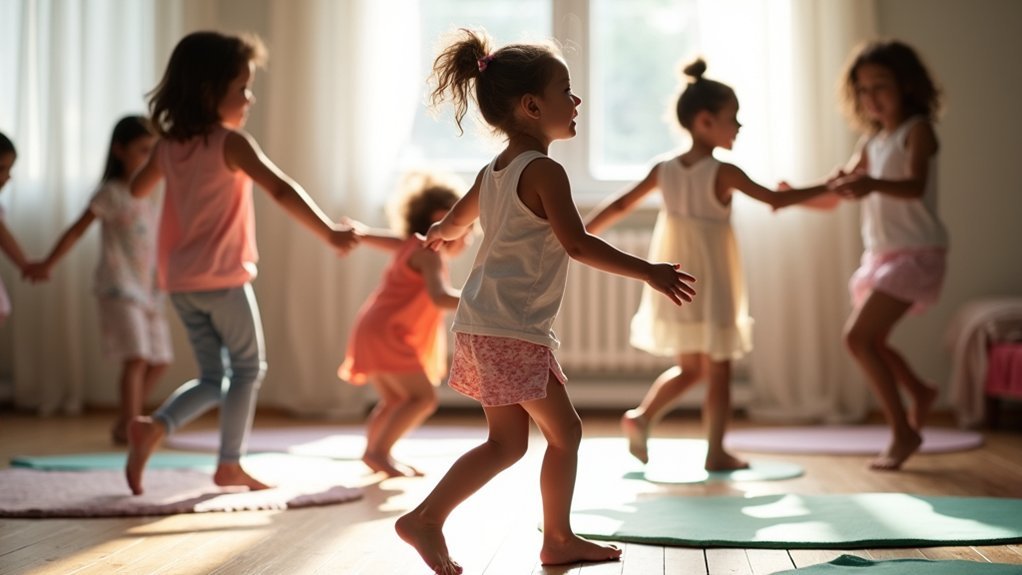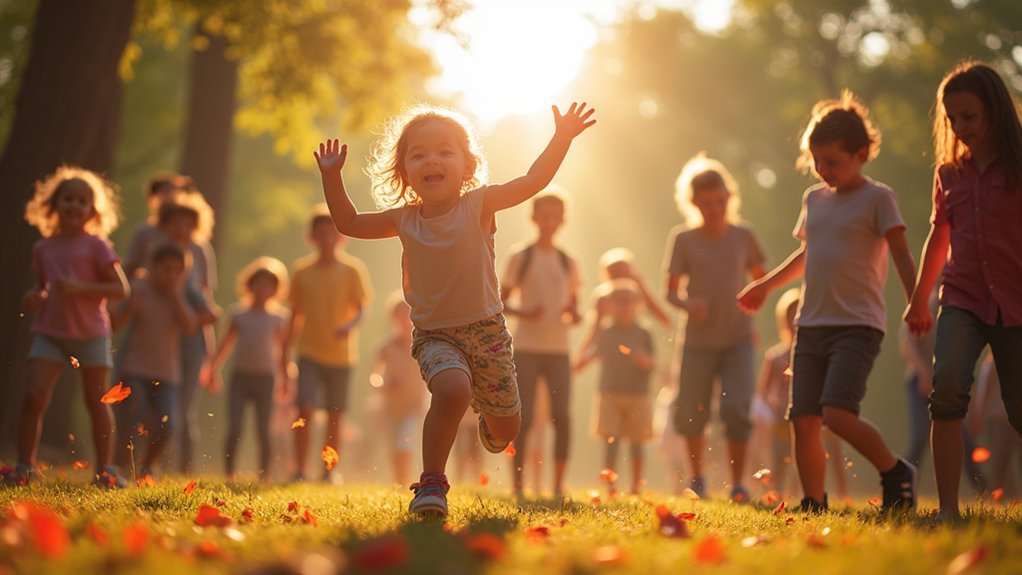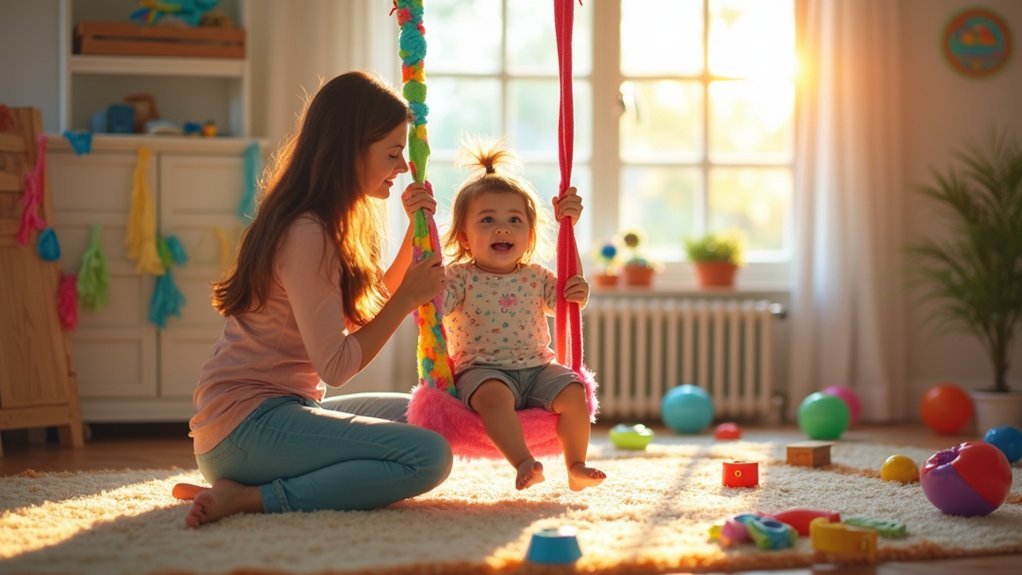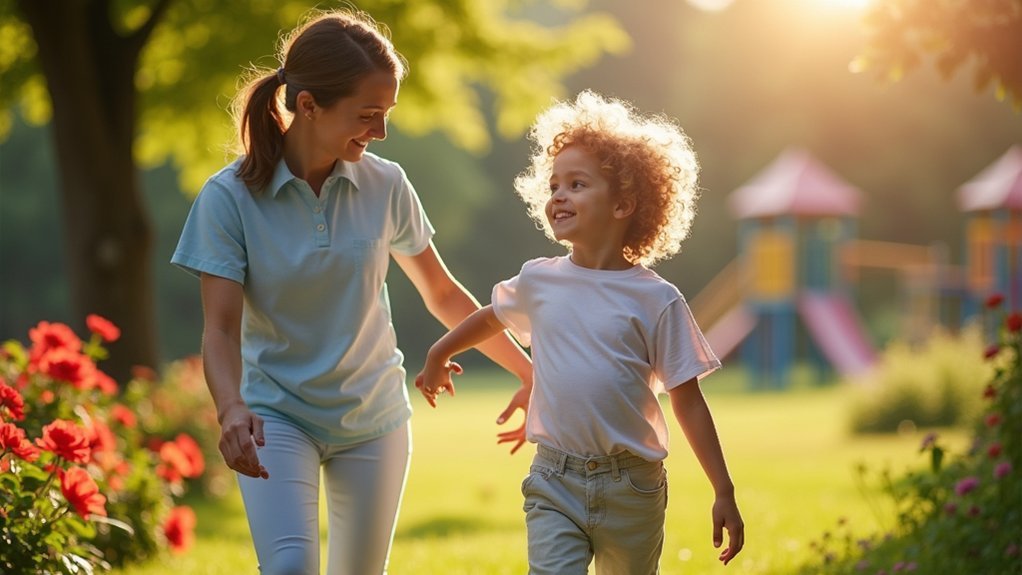Rhythmic movement transforms special needs care by stimulating brain development, enhancing focus, and improving emotional regulation. For children with autism or ADHD, consistent rhythmic activities can improve attention by 37% and reduce emotional meltdowns by 63%. These movements create natural pathways for nonverbal expression while calming the nervous system. You’ll find wheelchair-adaptable choreography makes these benefits accessible to all abilities. Discover how simple, daily rhythmic practices can revolutionize your child’s developmental journey.
The Science Behind Rhythmic Movement for Nervous System Development

While many therapies focus on cognitive approaches, rhythmic movement targets the neurological foundations that support learning and behavior.
When your child engages in rhythmic movement activities, they’re actually stimulating their prefrontal cortex—the brain region responsible for focus and impulse control.
Research shows that rhythmic auditory stimulation improves Attention in Children with ADHD by 37% with consistent practice. This happens because rhythmic activities help normalize cortical arousal, enabling better emotional and behavioral regulation.
Rhythmic auditory stimulation doesn’t just engage—it transforms the ADHD brain, normalizing arousal patterns for sustained attention and emotional balance.
You’ll also notice improvements in your child’s proprioception and spatial awareness as they practice these movements.
For children with autism spectrum disorder, the benefits extend to behavioral improvements and increased social brain connectivity—all critical developments that support their overall nervous system functioning and daily interactions.
Building Communication Bridges Through Movement Patterns
You’ll find that rhythmic movement creates natural pathways for nonverbal expression, allowing children with communication challenges to connect before mastering verbal skills.
Through rhythmic mirroring techniques, you’re establishing a foundation of reciprocal communication that transcends traditional language barriers.
These movement patterns serve as an essential bridge, helping children translate physical experiences into meaningful communicative exchanges with peers and caregivers.
Nonverbal Expression Pathways
For children with limited verbal abilities, rhythmic movement opens powerful communication channels that transcend traditional speech.
You’ll notice how structured rhythmic interventions like the VICON Method naturally enhance joint attention and foster social connections between children who might otherwise struggle to interact.
When you incorporate rhythmic activities into care routines, you’re providing:
- Visual and auditory models that help children express themselves without words
- Opportunities for spontaneous imitation, which directly supports language development
- Predictable patterns that calm the nervous system, creating an ideal state for nonverbal communication
The beauty of rhythm-based approaches is their accessibility—children intuitively respond to beats and movement sequences, remembering them more effectively than verbal instructions alone.
This memory enhancement becomes a foundation for building more complex communication skills.
Rhythmic Mirroring Techniques
Several powerful connections emerge when children and caregivers engage in synchronized movement patterns together. When you mirror a child’s movements or guide them to follow yours, you’re creating opportunities for joint attention that strengthen early communication skills.
These rhythmic patterns do more than entertain—they’re learning tools that align with natural speech cadences, helping children retain sounds and words more effectively.
For children with special needs, the predictable structure of mirroring activities like clapping or dancing provides emotional regulation support.
You’ll notice increased attention and participation during these shared experiences, as rhythm naturally helps children focus.
The turn-taking aspect of mirroring also builds essential social skills, allowing nonverbal children to communicate and connect through the universal language of movement.
Emotional Regulation and Self-Expression Through Rhythm

While many therapeutic approaches focus on verbal intervention, rhythmic movement offers a profound pathway to emotional regulation for children with special needs.
You’ll find that predictable rhythmic structures calm the nervous system, giving children tools to self-soothe during distress.
Improvisational music therapy has demonstrated remarkable results, reducing emotional meltdowns by up to 63% in autistic children.
Rhythmic intervention transforms emotional regulation, providing autistic children powerful tools that dramatically decrease meltdown frequency.
When you incorporate rhythmic activities, you’re helping children:
- Activate their brain’s reward system while calming the amygdala
- Develop significant turn-taking skills and empathy through shared musical experiences
- Build self-regulation capabilities essential for school readiness
Wheelchair Choreography: Adapting Movements for All Abilities
You’ll find that wheelchair choreography embraces inclusive rhythmic patterns that transform physical limitations into artistic opportunities.
When designing wheelchair dance routines, you’re creating pathways for movement that honor each participant’s unique mobility while maintaining the flow and harmony of the collective performance.
Your focus on adapting traditional dance elements—whether through mirrored arm sequences, synchronized wheelchair turns, or expressive hand gestures—allows everyone to experience the joy of rhythmic expression regardless of ability level.
Inclusive Rhythmic Patterns
Through carefully designed adaptations, wheelchair choreography transforms traditional dance into an accessible art form that embraces participants of all physical abilities.
When you incorporate inclusive rhythmic patterns into activities for children with special needs, you’re fostering both physical development and emotional expression.
These patterns create structured frameworks where participants can thrive:
- Simple repetitive movements – Allow children to anticipate sequences, building confidence and coordination.
- Call-and-response patterns – Encourage social engagement and turn-taking skills.
- Graduated complexity levels – Provide achievable challenges that evolve with participants’ abilities.
The rhythmic structure helps improve self-regulation while creating a sense of community.
You’ll notice enhanced body awareness and attention spans as participants engage with synchronized movements, ultimately transforming traditional therapy into a joyful, communal experience.
Flow Through Limitations
Despite physical constraints, wheelchair choreography opens up a world of expressive movement that transcends traditional limitations.
You’ll find that children with special educational needs particularly benefit from these adapted dance forms, as the rhythmic patterns improve cognitive functions like memory and attention.
When you implement wheelchair choreography as a movement intervention, you’re not just facilitating physical activity—you’re fostering inclusion and creativity.
Research shows participants experience improved self-esteem and enhanced social interactions alongside physical benefits like better motor skills and increased fitness levels.
These collaborative dance projects create powerful connections between able-bodied and disabled dancers.
Creating Sensory-Rich Movement Experiences for Special Needs

When children with special needs engage in structured rhythmic activities, they encounter powerful opportunities for developing essential skills that extend far beyond simple movement. Effective movement programs create environments where sensory processing can flourish, allowing children to interpret their world through rich, multisensory experiences.
To maximize these benefits, consider incorporating:
- Musical elements that provide predictable structures, helping children regulate emotions while stimulating neural pathways that support language development.
- Dance-based activities that enhance proprioception and spatial awareness, transforming physical limitations into opportunities for growth.
- Yoga-inspired movements that build motor skills while promoting mind-body connections that support cognitive development.
You’ll notice improvements in social interaction as children engage with peers through these structured rhythmic experiences, creating foundations for communication and emotional well-being.
The Role of Music in Enhancing Movement Therapy Benefits
Music serves as a powerful catalyst in movement therapy, magnifying therapeutic outcomes for individuals with special needs. When you incorporate structured musical interventions into your movement sessions, you’ll witness remarkable improvements in attention and skill development. Children with autism learn vocabulary 50% faster through music education that combines melody and lyrics.
| Music Element | Therapeutic Benefit |
|---|---|
| Rhythm | 37% increase in ADHD task persistence |
| Melody | Enhanced memory retention |
| Improvisation | 63% reduction in emotional meltdowns |
| Lyrics | Accelerated vocabulary acquisition |
| Structure | Normalized cortical arousal |
The neurological impact is significant—rhythmic activities normalize brain arousal in ADHD and increase social brain connectivity in children with autism. By integrating music into movement therapy, you’re not just creating enjoyment—you’re rewiring neural pathways for lasting development.
Group Dynamics and Social Connection Through Shared Rhythm
When you incorporate rhythmic movement activities in special needs care, you’ll notice children forming stronger bonds through synchronized clapping, swaying, and dancing together.
These shared experiences create safe spaces where children feel comfortable taking social risks and engaging with peers, reducing anxiety through the predictability of structured rhythmic play.
You’ll witness remarkable breakthroughs in non-verbal communication as children respond to each other’s movements and cues, developing essential skills for building meaningful social relationships in inclusive settings.
Synchronized Bonding Experiences
Through the power of synchronized movements, children with special needs discover pathways to meaningful social connections that might otherwise remain elusive.
When you implement rhythmic activities in your special education program, you’ll witness the positive impact on social interaction as children naturally engage in turn-taking and shared experiences.
Research confirms that synchronized movements create bonding experiences through:
- Neural pathway strengthening that enhances social cognition and response to social cues
- Emotional regulation development that reduces isolation and fosters group belonging
- Communication skill improvement that builds foundations for lasting peer relationships
You’ll notice that as children clap, dance, or move together, they’re not just exercising—they’re developing essential relationship-building tools.
These synchronized experiences create therapeutic opportunities for emotional bonding and social growth that transform special needs care.
Safety Through Group Play
The protective power of rhythmic group activities extends beyond social skills development to create genuine safety within special needs environments.
When children engage in structured rhythmic movement together, they experience a calming effect on their nervous systems, establishing a foundation where social connections can naturally flourish.
You’ll notice how these shared rhythmic experiences—whether clapping games or dance activities—provide a predictable framework that helps children feel secure while practicing critical interaction skills like turn-taking and cooperation.
This safety translates directly into measurable outcomes: a remarkable 63% reduction in emotional meltdowns during group music-making sessions for children with autism.
Non-Verbal Communication Breakthroughs
Despite having limited or no verbal abilities, children with special needs often discover powerful communication pathways through shared rhythmic experiences.
When you introduce structured rhythmic activities in group settings, you’ll witness how these movements create a universal language that transcends traditional speech barriers.
Rhythmic interaction triggers significant developmental milestones:
- Joint attention skills emerge naturally as children engage in turn-taking through clapping games and synchronized movements.
- Brain reward systems activate during group rhythmic exercises, fostering feelings of safety and belonging essential for social bonding.
- Emotional regulation improves as children learn to attune their responses to the group’s shared tempo.
These non-verbal communication breakthroughs help children with special needs develop vital social skills while experiencing the joy of meaningful connection with peers and caregivers.
Daily Rhythmic Practices for Home and Therapy Settings
When implemented consistently, daily rhythmic practices create powerful opportunities for developmental growth in children with special needs. You’ll find that singing songs with coordinated movements enhances imitation and joint attention, building essential communication foundations.
Try incorporating rhythmic exercises like clapping or tapping before therapy sessions to boost your child’s focus and participation. At home, movement-based games during playtime strengthen neural pathways that support vocabulary retention and speech patterns.
Structure your day with music breaks involving rhythmic movement to regulate emotions and sensory processing. This predictability calms children before challenging tasks.
Don’t overlook turn-taking clapping games, which naturally promote social interaction—a critical element for communication development. These simple yet powerful practices work equally well in professional settings and your daily home routine.
Measuring Progress: Tracking Development Through Movement Milestones
As your child progresses through rhythmic movement activities, tracking specific milestones provides essential insights into their developmental journey.
By monitoring their rhythmic abilities—clapping, tapping, and dancing—you’ll gain valuable data about their social and communication growth while measuring intervention effects over time.
Rhythm tracking reveals your child’s developmental story, illuminating social progress and communication breakthroughs with each beat.
When you document your child’s movement achievements, you’re creating a roadmap of their development that helps identify which strategies are working best.
Consider tracking these key areas:
- Motor skill improvements – correlating with enhanced attention span and focus
- Self-regulation capabilities – observed during structured rhythmic routines
- Engagement levels – noting how participation in rhythmic play evolves
This systematic tracking development approach allows you to celebrate incremental victories while providing therapists with concrete information to refine their support strategies.
Adaptive Equipment That Enhances Rhythmic Movement Potential
The right equipment can transform your child’s rhythmic movement experience from challenging to rewarding. Adaptive equipment like balance boards and stability balls improve proprioception and spatial awareness, making rhythmic activities more accessible while enhancing attention span during sessions.
For children with sensory processing challenges, weighted vests and ankle weights provide essential proprioceptive feedback, helping them feel grounded during movement. Specialized instruments enable children with limited motor skills to participate meaningfully in rhythmic expression.
Safety equipment isn’t forgotten—harnesses and supportive swings facilitate calming, rhythmic rocking that regulates emotions and soothes the nervous system.
Meanwhile, mobility aids such as gait trainers support children with physical disabilities, allowing them to explore movement independently and develop physical confidence through rhythmic exercises.
Parent-Caregiver Participation in Movement-Based Interventions
Parents and caregivers play a pivotal role in maximizing the benefits of rhythmic movement interventions for children with special needs. When you actively participate in these activities, you’re not just helping children develop—you’re strengthening your bond and improving communication with them.
Your involvement creates consistency between structured sessions and home practice, which reinforces developmental gains. Research confirms that parent-caregiver participation in rhythmic activities greatly improves children’s emotional regulation and social skills.
When caregivers join rhythmic activities, children develop stronger emotional skills while building crucial home-to-therapy connections.
To effectively support your child:
- Attend training programs to learn proper rhythmic movement techniques
- Implement daily practice routines that incorporate playful rhythmic elements
- Connect with other families to share experiences and build a supportive community
This collaborative approach empowers you as a caregiver while enhancing your child’s engagement and progress.
Frequently Asked Questions
What Are the Benefits of Rhythmic Movement?
Rhythmic movement helps you regulate emotions, strengthen memory, and develop communication skills. You’ll experience improved neural connections, better social interactions, and enhanced self-regulation while establishing predictable patterns that calm your nervous system.
What Are Rhythmic Movements for Autism?
Rhythmic movements for autism are structured activities like clapping, tapping, and dancing that you’ll find helpful. They’ll improve your child’s communication, emotional regulation, attention, memory retention, and social interaction skills through predictable patterns.
Is Rhythmic Movement Disorder Related to Autism?
Yes, rhythmic movement disorder can co-occur with autism. You’ll often notice repetitive body rocking, hand flapping, or head banging in autistic children as self-regulatory behaviors, though they’re distinct clinical conditions requiring different approaches.
What Is Rhythm and Movement for Self Regulation?
Rhythm and movement for self-regulation uses structured rhythmic activities to help you calm your nervous system, improve focus, and manage emotions. You’ll engage in predictable patterns that strengthen your ability to control impulses and responses.
In Summary
You’ll find that rhythmic movement isn’t just an activity—it’s a transformative approach to special needs care. By incorporating these structured movements into daily routines, you’re helping develop neural pathways, enhance communication, and promote emotional regulation. Whether you’re adapting wheelchair choreography or creating sensory-rich experiences, you’re building a foundation for meaningful progress. Start small, stay consistent, and you’ll witness remarkable changes in development and connection.





Leave a Reply